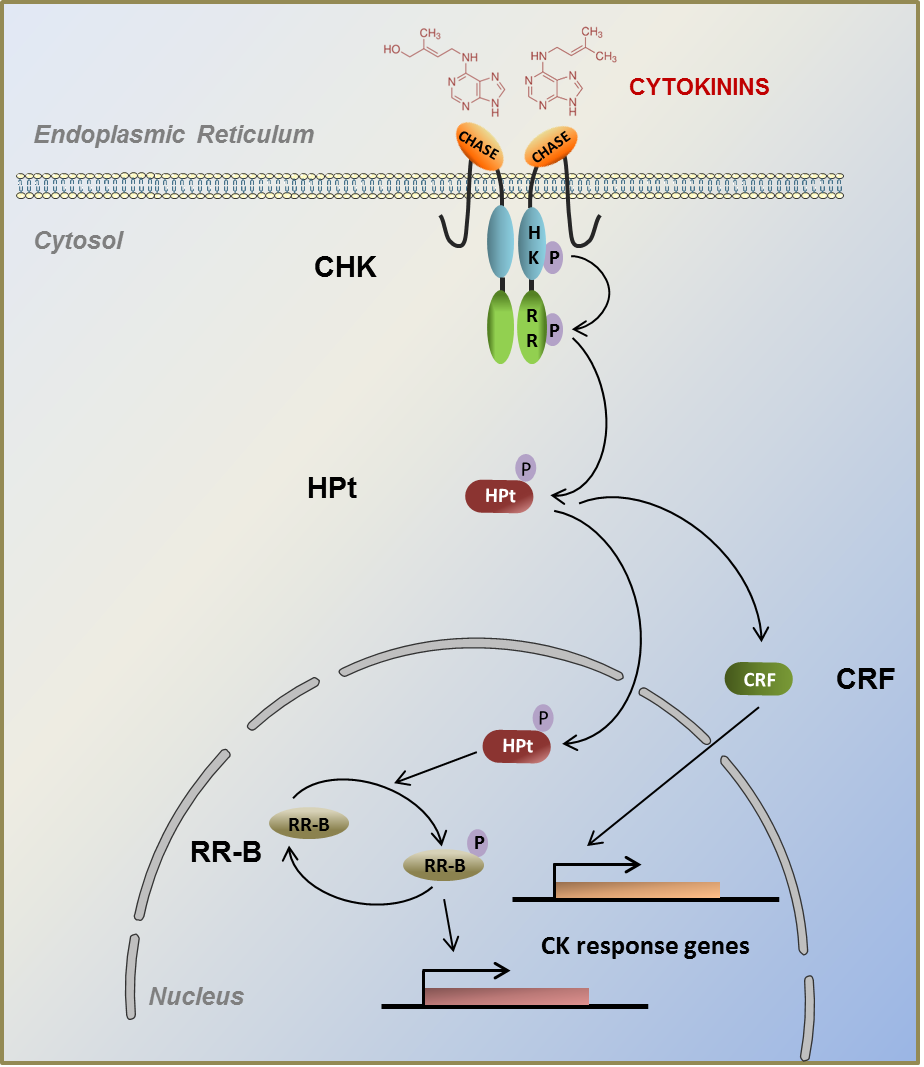Cytokinin signaling

|
Recently, cytokinin (CK) signaling has emerged as a major factor in plant-microbe and plant-insect interactions. Not only plants synthesize CK, but pathogens such as bacteria or fungi can also produce them. Interestingly, plant- and pathogen-derived CK could inversely affect the plant defense response through the modulation of CK signaling. In plants, CK signaling involves a phosphotransfer cascade composed by histidine-kinase receptors (CHK), histidine phosphotransfer proteins (HPt), response regulators (RR) and CK-response factors (CRF). Research programs performed by the EA2106 BBV team are also focused on the role of CK signaling in apple tree (Malus x domestica) challenged with pathogens or insects. Apple is one of the major fruit crops produced in the world and is submitted to a wide range of pathogens (Erwinia amylovora and Venturia inaequalis, the causal agents of fire blight and apple scab respectively) and pests that caused dramatic damages on cultures. The recent sequenced apple genome allowed us to start identifying the components of CK signaling, especially MdCHK and MdHPt. Now we are currently (i) establishing the functional characterization of the MdCHK in biotic interactions, (ii) determining the MdCHK-MdHPt interaction network. In parallel, we are also studying the “molecular signature” of CK signaling pathways in plant-microbe/insect interactions by bioinformatics tools. |
|  | ↑ Cytokinin signaling pathway is mediated by a two-component system including CHK (cytokinin histidine kinase), HPt (Histidine Phosphotransfer protein), RR (Response Regulator) transcription factors and CRF (cytokinin response factor). |
Contact: Gaëlle Glévarec
Publications:
|
Giron, D. & Glevarec, G. (2014). Cytokinin-induced phenotypes in plant-insect interactions: learning from the bacterial world. J Chem Ecol 40, 826–35. Senoussi, M., Crèche, J., Rideau, M. & Djekoun, A. (2013). Effect of cytokinin in processing at long term on the production of indole alkaloids in periwinkle cellular suspensions. Ann Biol Res 4, 97–101. Héricourt, F., Chefdor, F., Bertheau, L., Tanigawa, M., Maeda, T., Guirimand, G., Courdavault, V., Larcher, M., Depierreux, C., Bénédetti, H., Morabito, D., Brignolas, F., & Carpin, S. (2013). Characterization of histidine-aspartate kinase HK1 and identification of histidine phosphotransfer proteins as potential partners in a Populus multistep phosphorelay. Physiol Plant 149, 188–99. Giron, D., Frago, E., Glevarec, G., Pieterse, C. M. J. & Dicke, M. (2013). Cytokinins as key regulators in plant-microbe-insect interactions: connecting plant growth and defence. Funct Ecol 27, 599–609. Bertheau, L., Miranda, M., Foureau, E., Rojas Hoyos, L. F., Chefdor, F., Héricourt, F., Depierreux, C., Morabito, D., Papon, N. , Clastre, M., Scippa, G. S., Brignolas, F., Courdavault, V. & Carpin, S. (2013). In planta validation of HK1 homodimerization and recruitment of preferential HPt downstream partners involved in poplar multistep phosphorelay systems. Plant Biosyst 147, 991–995. Amini, A., Andreu, F., Glévarec, G., Rideau, M. & Crèche, J. (2012). Down-regulation of the CrHPT1 histidine phosphotransfer protein prevents cytokinin-mediated up-regulation of CrDXR, and CrG10H transcript levels in periwinkle cell cultures. Mol Biol Rep 39, 8491–6. Bertheau, L., Chefdor, F., Guirimand, G., Courdavault, V., Depierreux, C., Morabito, D., Brignolas, F., Héricourt, F. & Carpin, S. (2012). Identification of five B-type response regulators as members of a multistep phosphorelay system interacting with histidine-containing phosphotransfer partners of Populus osmosensor. BMC Plant Biol 12,241. Amini, A., Glévarec, G., Andreu, F., Rideau, M. &Crèche, J. (2009). Low levels of gibberellic acid control the biosynthesis of ajmalicine in Catharanthus roseus cell suspension cultures. Planta Med 75, 187-91. Amini, A., Glévarec, G., Andreu, F., Reverdiau, P., Rideau, M. & Crèche, J. (2008). Effects of phosphatidic acid on cytokinin signal transduction in periwinkle cells. J Plant Growth Regul 27, 394-9. Giron, D., Kaiser, W., Imbault, N. &Casas, J. (2007). Cytokinin-mediated leaf manipulation by a leafminer caterpillar. Biol Lett 3, 340-3. Papon, N., Bremer, J., Vansiri, A., Glévarec, G., Rideau, M. & Crèche, J. (2006). Molecular cloning and expression of a cDNA encoding a hybrid histidine kinase receptor in tropical periwinkle Catharanthus roseus. Plant Biol 8, 731-6. Papon, N., Vansiri, A., Gantet, P., Chénieux, J.-C., Rideau, M. &Crèche, J. (2004). Histidine-containing phosphotransfer domain extinction by RNA interference turns off a cytokinin signalling circuitry in Catharanthus roseus suspension cells. FEBS Lett 558, 85-8. Papon, N., Senoussi, M.M., Andreu, F., Rideau, M., Chénieux, J.-C. &Crèche J. (2004). Cloning of a gene encoding a putative ethylene receptor in Catharanthus roseus and its expression in plant and cell cultures Biol Plant 48, 345-50. Papon, N., Bremer, J., Vansiri, A., Gantet, P. Chénieux, J.-C., Rideau, M. &Crèche, J. (2004). Emergence des voies de transduction de type histidine-aspartate kinase chez les végétaux. Regard sur la biochimie, 2, 23-35. Papon, N., Oudin, A., Vansiri, A., Rideau, M., Chénieux, J.-C. &Crèche, J. (2003). Differential expression of two type-A response regulators in plants and cell cultures of Catharanthus roseus (L.) G. Don. J Exp Bot 54, 1793-5. Papon, N., Clastre, M., Gantet, P., Rideau, M., Chénieux, J.-C. &Crèche, J. (2003). Inhibition of the plant cytokinin transduction pathway by bacterial histidine kinase inhibitors in Catharanthus roseus cell cultures. FEBS Lett 537, 101-5. Papon, N., Clastre, M., Andreu, F., Gantet, P., Rideau, M., & Crèche, J. (2002). Expression analysis in plant and cell suspensions of CrCKR1, a cDNA encoding a histidine kinase receptor homologue in Catharanthus roseus (L.) G. Don. J Exp Bot 53, 1989-90. Papon, N., Oudin, A., Clastre, M., Rideau, M., Chénieux, J.-C. &Crèche, J. (2002). Isolation of CrHPt1, a cDNA encoding a histidine-containing phospho-transfer domain in Catharanthus roseus. Acta Bot Gall 149, 67-77. |
Â